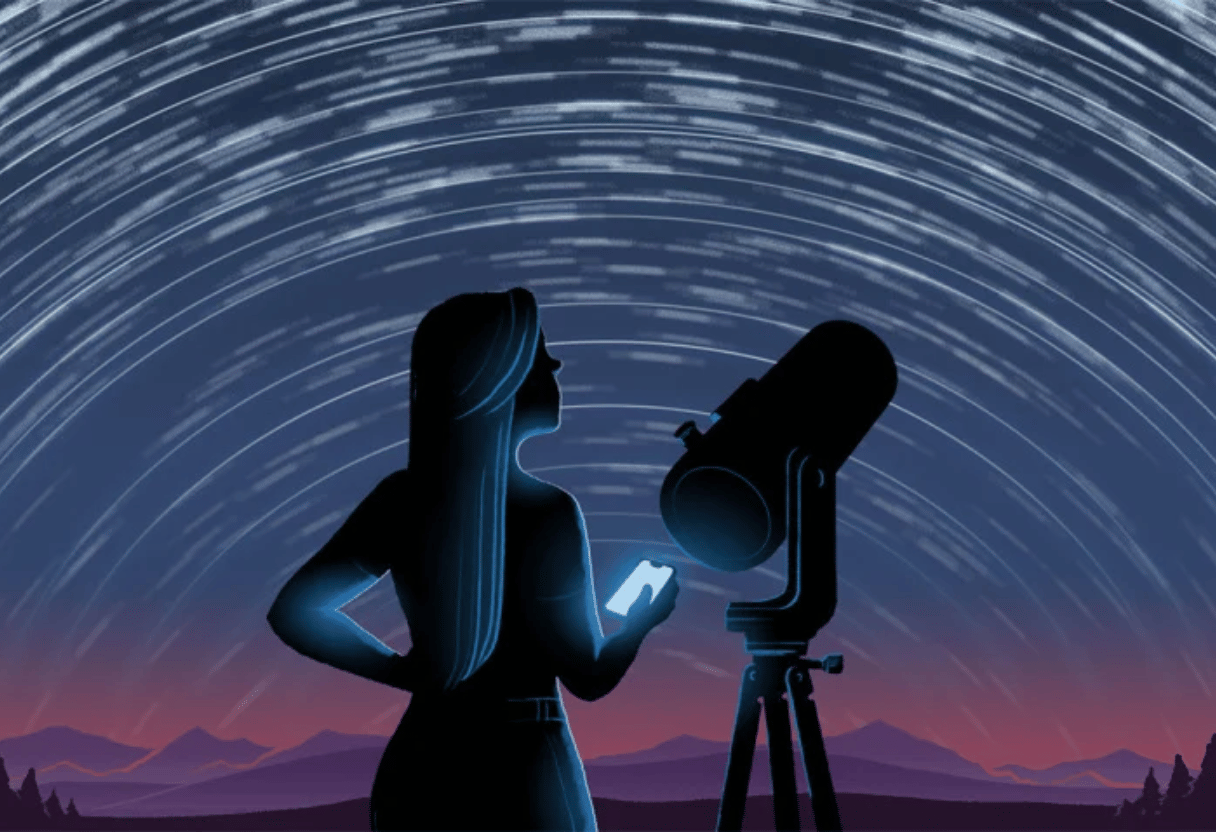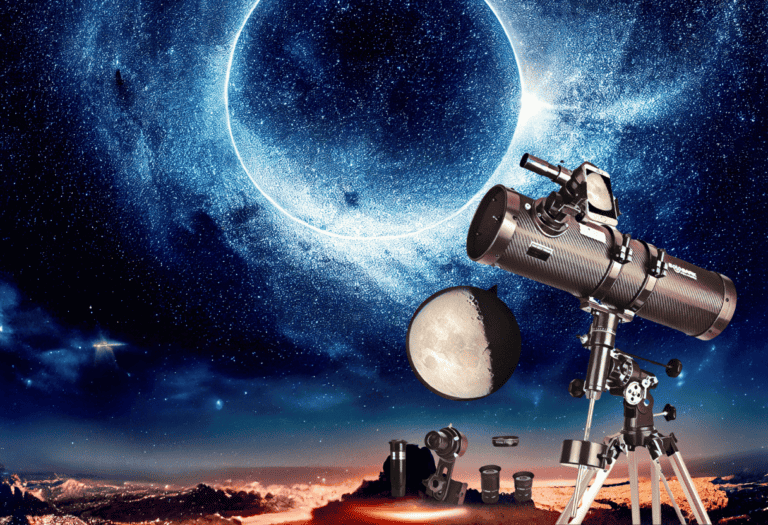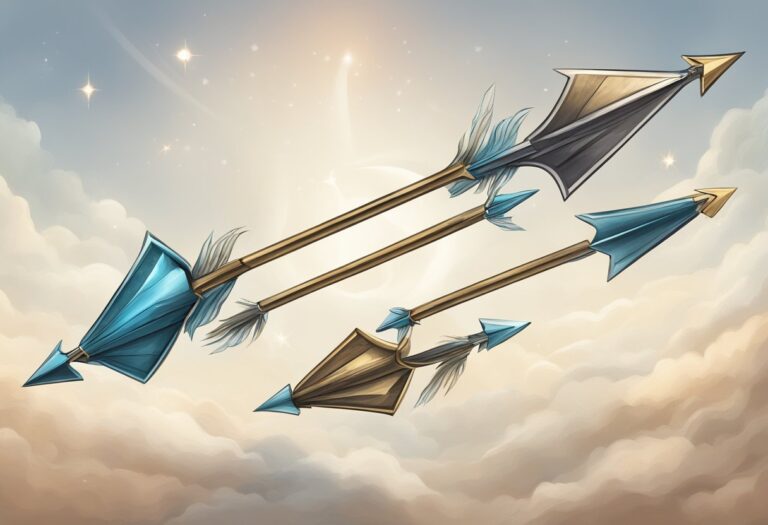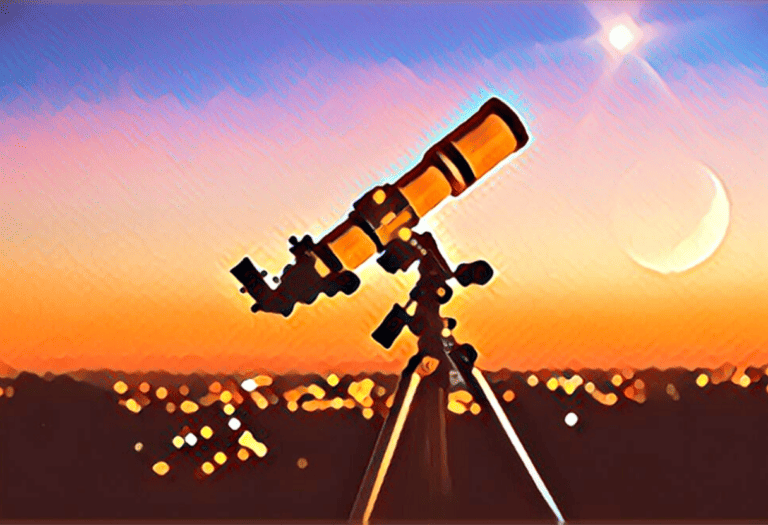Are you ready to transform your smartphone into a powerful tool for capturing the beauty of the cosmos?
With the advancement of technology, smartphone telescope adapters have become a game-changer for amateur astronomers and astrophotography enthusiasts. These innovative devices allow you to effortlessly connect your smartphone to a telescope, combining the magnification power of the telescope with the sophisticated camera capabilities of modern smartphones.
Well, we’ll be going over:
- The key considerations when selecting a smartphone telescope adapter, including compatibility with your device, build quality for stability and durability, and adjustability for ease of use and precise alignment.
- The importance of finding an adapter that offers a stable connection to prevent blurring and ensure clear, sharp images of celestial wonders.
- A selection of the best smartphone telescope adapters on the market, highlighting their features, benefits, and suitability for different types of smartphones and telescopes.
Whether you’re an experienced astronomer or just starting in astrophotography, these adapters will help you capture stunning images of the night sky with ease and precision.
Let’s dive in.
Top Smartphone Telescope Adapters
- Celestron NexYZ Adapter – Top Pick
- TRIDAPTOR Smartphone Adapter
- Gosky Smartphone Adapter
- Celestron Smartphone Adapter
- APEXEL Smartphone Adapter
After thorough research and hands-on testing, I’ve compiled a list of the top smartphone telescope adapters that stand out in terms of their build quality, ease of use, and ability to securely attach a phone to a variety of telescopes. Whether you’re an avid astronomer or just getting started with astrophotography, these adapters will help you capture clear, detailed photos of celestial objects right from your phone.
Celestron NexYZ Adapter

I’d recommend the Celestron NexYZ to anyone looking to easily connect their smartphone to various optical devices for capturing high-quality photos and videos.
Pros
Cons
As someone passionate about both astronomy and photography, finding the Celestron NexYZ was akin to striking gold. It’s impressive how quickly I can now transition from viewing with my eyes to shooting stunning celestial images with my phone. The ease of attaching it to my telescope was truly a game-changer.
Securing the phone in the adapter felt reassuringly sturdy, and the padded clamp eliminated any concern about scratching my eyepiece. What really stood out, though, was the three-axis adjustment mechanism. Even a slight knob turn allowed for precise alignment, and I could switch from portrait to landscape in seconds.
When showing off Saturn’s rings to friends, switching devices was a breeze. At our last star party, I didn’t miss a beat. Sharing views and photos with fellow enthusiasts didn’t mean laboriously unscrewing devices and potentially missing a fleeting comet or meteor. The adapter held firm even as we swapped between multiple phones.
TRIDAPTOR Smartphone Adapter
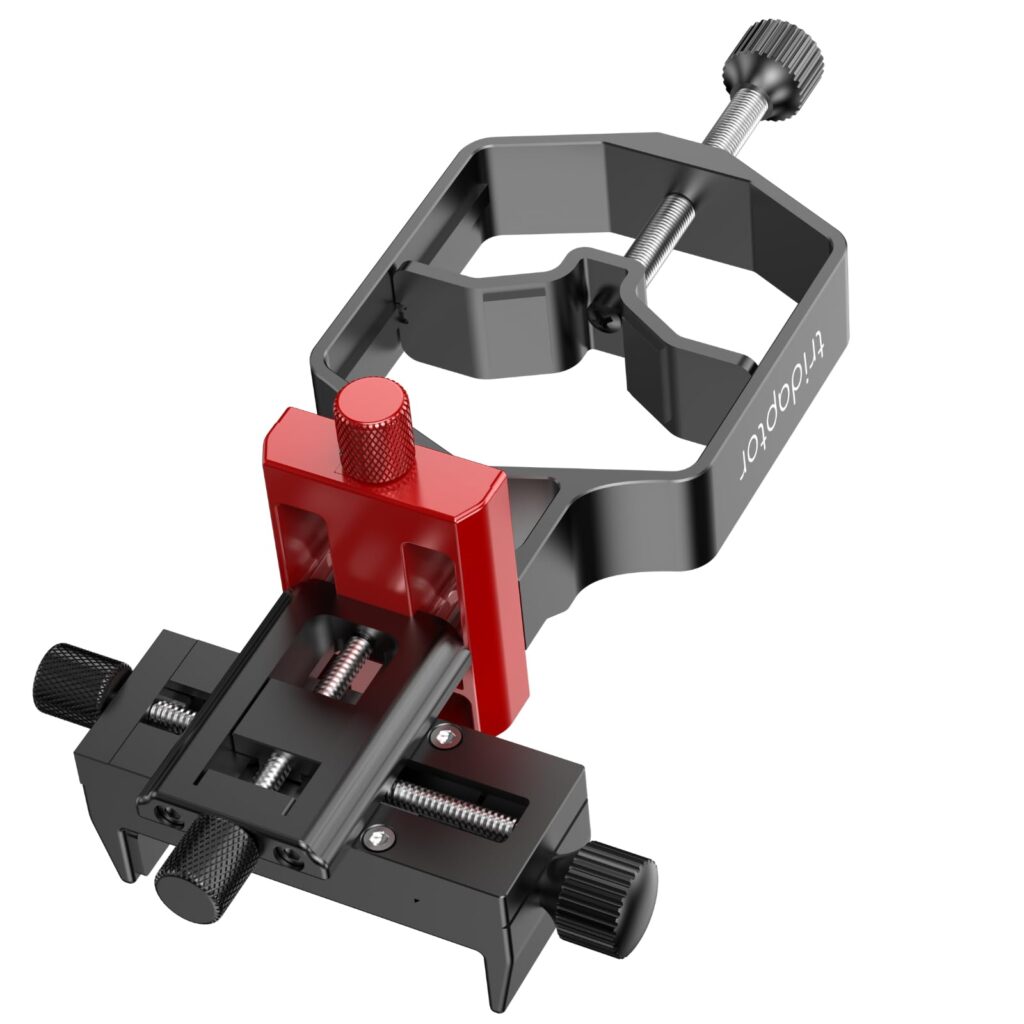
After testing this product, I believe it’s a must-have for any avid stargazer or outdoor enthusiast wanting to capture the wonders through their scopes with a smartphone.
Pros
Cons
Ever peaked through a telescope and wished you could capture that stunning celestial body on your smartphone? Then the TRIDAPTOR Smartphone Adapter is your answer. Its robust metal body and meticulous design impressed me right from unboxing. Aligning my phone with my telescope’s eyepiece felt intuitive, even indulgent, with the fine XYZ adjustments at my fingertips. The adapter clung securely to my device, thwarting any fear of it slipping mid-use.
In use, the high precision adjustment truly stands out. I’ve tried capturing the craters of the moon, and the adjustments on this adapter make it easy to ensure my phone’s camera aligns perfectly with the eyepiece, every single time. No more guesswork, no more blurry photos—just the thrill of astrophotography at your disposal.
Outdoor enthusiasts will find the adapter’s versatility its biggest selling point. Whether you’re into stargazing, bird watching, or distant landscape photography, this adapter transitions seamlessly to each activity. While it may seem costly compared to others, the value lies in its universality and durability. You’re not just buying a tool; you’re making an investment into all your future adventures.
However, perfection is not without its trade-offs. Achieving the precise alignment can be time-consuming, especially in the dark. You might find yourself twisting knobs for the perfect shot while the celestial event unfolds above you. And yes, it’s a little heavier on the wallet. But when you’re out there, under the stars, capturing the universe one shot at a time, these cons feel trivial compared to the cosmic clarity you achieve.
Gosky Smartphone Adapter
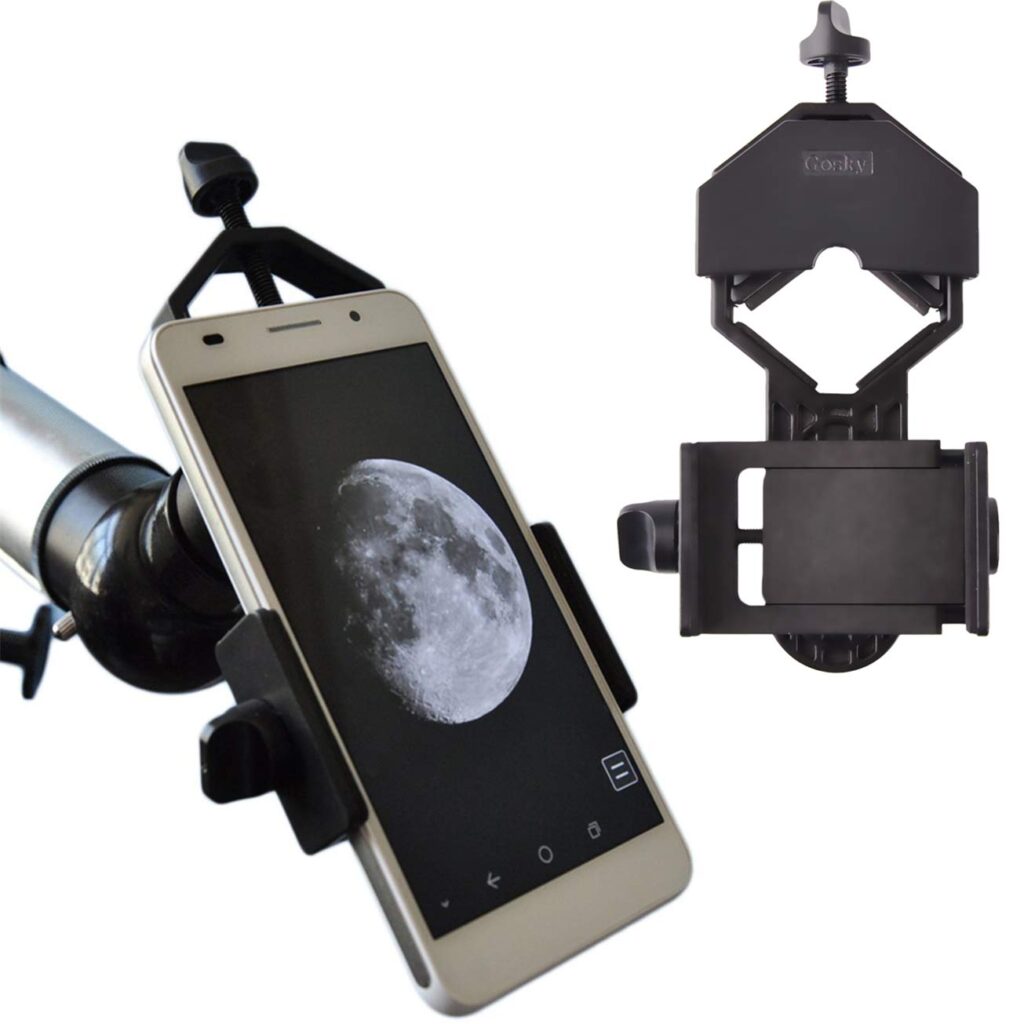
I found this adapter to be quite the handy tool, helping to bridge the gap between smartphone photography and the awe-inspiring magnification of binoculars and telescopes.
Pros
Cons
After taking this Gosky adapter out for a spin, I quickly discovered how intuitive the setup was. In just a few minutes, I had my smartphone securely attached to my scope. The solid construction was immediately noticeable. It reassured me that my device was held sturdily—a relief, especially when positioning over concrete or hard surfaces.
During use, I appreciated how smoothly it accommodated my iPhone. Its flexibility became apparent as I easily adjusted it to grip my friend’s Samsung, demonstrating its universal design. However, it’s worth mentioning that getting the phone’s camera lens perfectly aligned with the optical device’s eyepiece took some patience. Novices might need a few attempts to nail this critical step.
Yet, once aligned, capturing crisp images of the moon’s surface felt effortless. The adapter’s stability meant there were no concerns over camera shake—a common issue when taking photos by hand. This ease of use reflects the design’s attention to detail, but it could be seen as bulky when attached to more compact binoculars or monoculars.
Overall, whether I’m gazing at the stars or spying wildlife, the Gosky Smartphone Adapter has elevated my viewing experience—allowing me to capture and share those sights that leave me in awe.
Celestron Smartphone Adapter

I found this adapter to be a reliable tool for amateur astronomers or nature buffs who want to photograph their sightings with their smartphone.
Pros
Cons
After taking this Celestron adapter out for a night under the stars, I was pleased with how quick it was to set up. Popping my phone in, I tightened the knobs, and it stayed secure throughout my session. Aligning my phone’s camera with the eyepiece was straightforward, and soon I was capturing crisp images of the Moon.
During daylight, I switched to birdwatching with my scope. Again, the adapter effortlessly connected my phone, allowing me to snap shots of distant birds. Despite several adjustments as I moved between sightings, the mechanism remained firm and steady.
However, I noticed that my friend’s phone case was too bulky, which meant we had to remove it to fit the adapter. This wasn’t a huge deal, but it added an extra step. I also had to fiddle a bit every time I wanted to vertically align the camera lens with the eyepiece, but once I found the sweet spot, the results were worth it. While attaching to the eyepiece, I had to make sure to clamp it down well to avoid any slippage.
Overall, my experience with the Celestron adapter was positive. It’s undeniably a straightforward, effective way to delve into digiscoping without needing complex setups.
APEXEL Smartphone Adapter

I found this adapter to be a reliable tool for amateur astronomers and photographers wanting to capture the cosmos with their smartphones.
Pros
Cons
My experience with the APEXEL Telescope Phone Adapter was mostly positive. I appreciate how swiftly I could attach it to my phone and telescope. The adapter skipped the cumbersome screw adjustments commonly found in similar gadgets, saving me time and frustration.
Its compatibility with various devices stood out. I could switch between my iPhone and a friend’s Samsung without a hitch. Moreover, the damage-free silicone grip meant I could secure my phone without worrying about pressing any buttons accidentally.
However, while the adapter claims to accommodate a range of eyepiece diameters, I hesitated when attaching it to bulkier eyepieces. My phone felt a tad unsteady at times, particularly when repositioning the telescope, which could potentially disturb a carefully aligned shot.
On the flip side, this adapter’s portability impressed me. It barely took up space in my backpack, and its lightweight design was hardly noticeable. This aspect is a significant plus for outdoor enthusiasts who are conscious of gear weight.
In conclusion, the APEXEL Adapter is a solid choice for anyone looking to dive into astrophotography without complex setups and high-end equipment. While not without its limitations, its ease of use and broad compatibility make it an attractive option, especially for beginners.
Buying Guide
Compatibility
Firstly, I ensure that the telescope adapter is compatible with my smartphone model. The adapter should ideally accommodate a range of phone sizes, securing my device firmly in place.
- Adjustability: Look for an adapter that is adjustable to fit different phone sizes and telescope eyepieces.
Build Quality
I prioritize robust construction for durability. Good materials like metal and high-quality plastics resist wear better and hold the phone steady.
- Materials: Select adapters made from sturdy materials.
- Design: Opt for a design that holds the phone securely without obscuring the camera lens.
Ease of Use
I want an adapter that is easy to attach and detach from both the telescope and the smartphone. This makes my experience smoother and more enjoyable.
- Attachment Mechanism: Choose an adapter that is easy to attach without needing extra tools.
Stability and Precision
The adapter must offer stability and precision. It should not wobble, ensuring clear images of celestial objects.
- Secure Fit: Ensure the adapter can be tightened adequately to prevent movement.
Price
I consider the price point carefully, looking for value rather than just the lowest cost. A quality adapter at a mid-range price can often provide the best balance between cost and functionality.
- Value for Money: Aim for the best quality within your budget, avoiding both cheaply made and overpriced adapters.
By considering these factors, I make an informed decision on the best smartphone telescope adapter for my needs, without succumbing to marketing hype or overspending on features that do not enhance the observing experience.
Frequently Asked Questions
When exploring smartphone telescope adapters, it’s essential to prioritize compatibility, ease of use, and build quality. I’ll address common questions to help you choose the right adapter for your needs.
What are the top features to look for in a smartphone telescope adapter?
I recommend looking for a sturdy build, precise alignment capabilities, and adjustability to fit various phone models. Additionally, a good adapter should have padding to protect your phone and telescope from scratches.
How can I securely attach an iPhone 14 to a telescope?
For securely attaching an iPhone 14, you need a telescope adapter with adjustable clamps or brackets specifically designed for the iPhone’s size and camera positioning. Ensure the adapter is compatible with the iPhone 14’s dimensions for a secure fit.
What are the benefits of using the Celestron NexYZ 3-axis universal smartphone adapter?
The Celestron NexYZ adapter offers three-axis adjustment, allowing for precise alignment with the telescope eyepiece. Its durable construction and universal compatibility make it a versatile choice for many smartphones and telescopes.
Is it possible to attach any smartphone to a telescope with a universal adapter?
Most universal adapters are designed to fit a wide range of smartphones, thanks to their adjustable features. However, check the adapter’s specifications to ensure it can accommodate your smartphone’s size and weight.
How do ACCUVIEW Smartphone Adapters compare to other brands?
ACCUVIEW adapters generally provide a reliable connection between your smartphone and telescope, often featuring easy-to-use designs and secure fittings. Compared to other brands, they strike a balance between quality and affordability.
Can you recommend a sturdy telescope phone adapter that can be 3D printed?
While I cannot endorse a specific model, there are 3D-printable designs available online that offer robustness similar to commercial options. Look for a design with a secure locking mechanism and compatibility with your smartphone and telescope’s eyepiece diameter.

